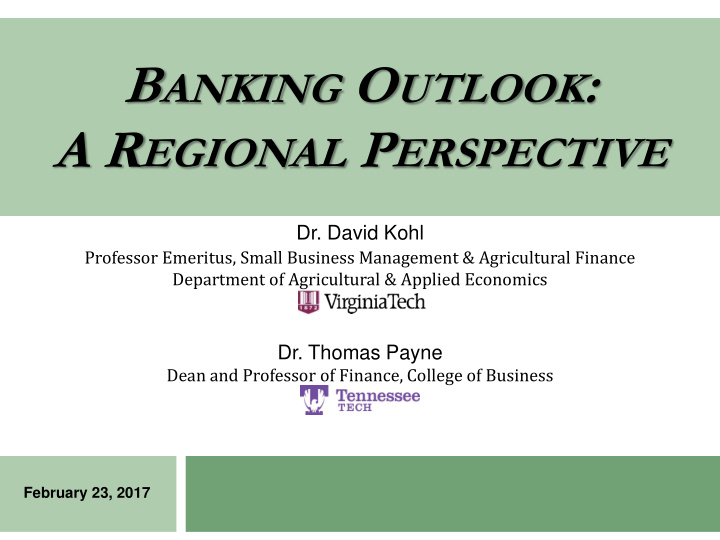



B ANKING O UTLOOK : A R EGIONAL P ERSPECTIVE Dr. David Kohl Professor Emeritus, Small Business Management & Agricultural Finance Department of Agricultural & Applied Economics Dr. Thomas Payne Dean and Professor of Finance, College of Business February 23, 2017
Pulse of the Global Economy The View from 30,000 Miles Up NASA Photo 2
Globalism 1945 to 2015 drivers of change reconstruction Europe & Japan China, BRICS & KIMT’s baby boomers technology European Union- Euro 3
Nationalism & Populism Drivers of change: unravel of European union/euro bifurcated earnings and wealth rich nations protection trade millennial demographics globally immigration and youth China to India and others temporary or long term? 4
Global Economics: Europe Brexit immigration issues next year’s elections break up of euro other 5
Global Economics: China TPP: China’s role water, soil, & air issues asset bubbles: stock real estate other military buildup South China Sea 6
New Administration international trade banking regulations health care immigration taxation trillion dollar infrastructure spending 7
Laffer’s Curve and Hauser’s Law law of diminishing returns and taxes: 0 v. 100% tax rate and policy changes since 1950 tax revenues - percentage of GDP implications for tax policy – growing the pie 8
U.S. – Global Competitiveness 9
Automation’s Impact Manufacturing - Jobs and Output 10 Data on manufacturing output and jobs from the Bureau of Economic Analysis www.bea.gov
Increasing Income Inequality – Not a New Phenomenon The Gini index is a measurement of income disparity. Ranging between 0 and 1 it describes the income gap with 0 = perfect equality and 1 = complete inequality. Trend lines of income inequality Source: U.S. Bureau of the Census; Federal Reserve Bank of St. Louis – FRED (2017) 11
The Skills Gap -- Why Education Matters Educational Total Unemployment Labor Force Median Annual Level Labor Force Rate Participation Income (thousands) Rate No High School 10,533 7.7% 45.3% $25,686 Diploma High School Graduate, no 35,443 5.3% 57.9% $35,256 college Some College or $38,376 Associate 38,007 3.8% 65.7% Degree $41,496 Bachelor’s $59,124 Master’s $69,732 54,271 2.5% 73.8% Professional $89,960 PH.D. $84,396 Source: U.S. Bureau of Labor Statistics (January 2017); median income data from 2015 12
Wage and Productivity Growth Slow wage and productivity growth since 2011; and, until recently, the red line - providing a measure of the growth in productivity generally resides above the blue wage growth line. This is consistent with income disparity and has contributed to low inflation. The recent “blue line” increase supports labor market tightening and is consistent with coming increases in inflation and interest rates . 13 Source: U.S. Bureau of the Census; Federal Reserve Bank of St. Louis – FRED (2017)
Wage Growth – Switchers and Stayers Source: Federal Reserve Bank of Atlanta, Center for Human Capital Studies, February 2017 – Wage Tracker (https://www.frbatlanta.org/chcs/wage- growth-tracker.aspx?panel=1); BLS Data 14
Wage Growth – Prime Age (25-54) Source: Federal Reserve Bank of Atlanta, Center for Human Capital Studies, February 2017 – Wage Tracker (https://www.frbatlanta.org/chcs/wage- growth-tracker.aspx?panel=1); BLS Data 15
Labor Force Participation Rate At its lowest overall levels (62.9%) since 1978 the Labor Force Participation Rate is showing signs of improvement….. 16 Source: Federal Reserve Bank of St. Louis (FRED); Bureau of Labor Statistics (February 2017)
Prime Age Labor Force Participation Rate (Ages 25-54) 17 Source: Federal Reserve Bank of St. Louis (FRED); Bureau of Labor Statistics – (February 2017)
The Participation Rate Conundrum Unemployment Rate Increases …. Good News for Labor Force Participation! Aging Baby Boomers – note that retirees are classified as “not working and not looking for work”; Later Retirement – while this adds to workforce participation, it does not offset the aging of the large baby boom population; Increased Disability ; Extended Education and Training – while this will pay dividends in the future - many “twenty somethings” are out of the labor force; Increased Number of People Who Do Not Want a Job 18
Top U.S. Ag Exports Percentage exports of total production 2011-2013 Crop Percentage (rounded) Cotton 77% Tree Nuts 72% Rice 52% Wheat 51% Soybeans 46% Fresh Fruit 28% Processed Vegetables 25% Pork 22% Source: USDA Economic Research Service 19
Top Destinations of U.S. Ag Exports Country Billion Dollars Rounded Canada $21 China $20 Mexico $18 EU-28 $12 Japan $11 South Korea $6.0 Hong Kong $3.6 Taiwan $3.0 Colombia $2.4 Philippines $2.3 Vietnam $2.2 20 Source: USDA Economic Research Service
Agricultural & Rural Areas Southeast international trade strong dollar transformative trends consumer technology millennials urban rural disconnect rural areas 20% agricultural net income from exports 21
Pulse of Banking The Share of Total Assets by Size 22 Source: FDIC (Knoema.com chart - 2017)
Pulse of Banking Efficiency Ratio 23 Source: FDIC (Knoema.com chart - 2017)
The State of Banking – Across the Region and Beyond scale matters asset quality and growth profitability regional and locational economic disparity workforce development 24
U.S. Economic Dashboard LEI/Diffusion Index Consumer Confidence positive >90 green light 80-90 yellow light three months rule diffusion index <80 red light PMI GDP > 50 expansion 3-4% green light <50 contraction 1-2% yellow light <41 recession negative = real recession Housing Starts >1.5 million green light 800,000 to 1.5 million yellow light <800,000 red light 25
Federal Reserve’s Interest Rate Barometer • Three increases in 2017! Indicator Status Unemployment/Job 4.8%/180K/2.5% Growth/Wage Growth GDP Growth 1.9% Inflation 2.5% Consumer Sentiment >90% • stock market/real estate wealth effect • copper prices 26
T HANK Y OU ! Dr. David Kohl Professor Emeritus, Small Business Management & Agricultural Finance Department of Agricultural & Applied Economics Dr. Thomas Payne Dean and Professor of Finance, College of Business February 23, 2017
Recommend
More recommend